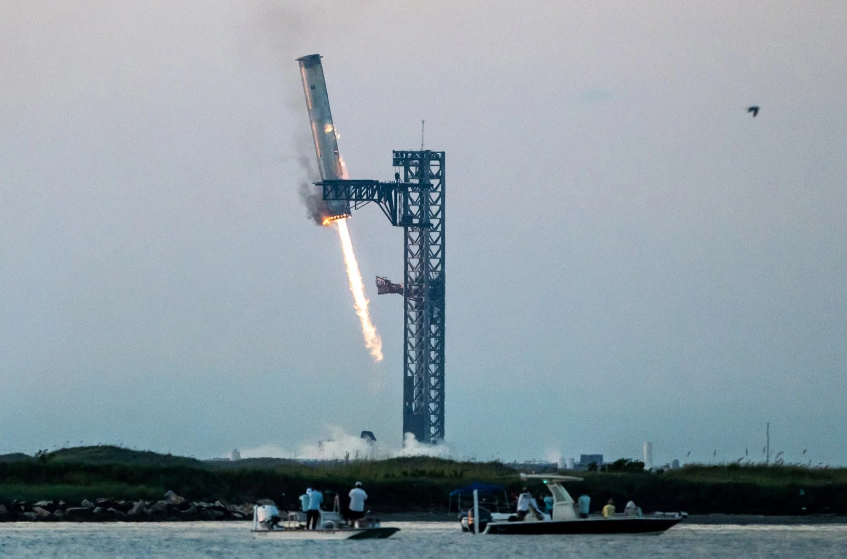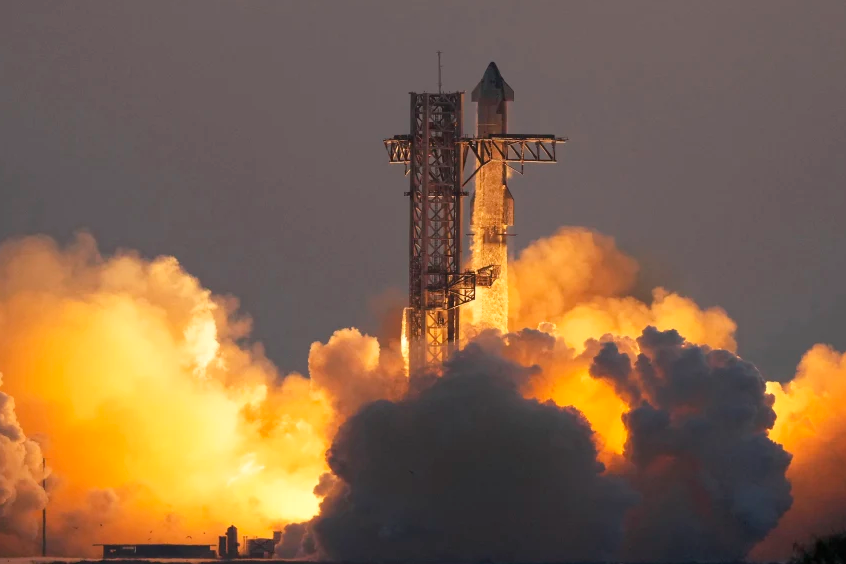SpaceX Achieves Milestone with Fifth Starship Test Flight
On Sunday, SpaceX successfully launched its fifth test flight of the Starship rocket, marking a significant achievement with the dramatic catch of the rocket’s more than 20-story tall booster. This event represents a major step forward in SpaceX’s ambitious goal of creating a fully reusable rocket system.
Launch Details
The Starship took off at 8:25 a.m. ET from the company’s Starbase facility near Brownsville, Texas. The rocket’s Super Heavy booster made a successful return, landing on the arms of the company’s launch tower nearly seven minutes post-launch.
“Are you kidding me?” exclaimed SpaceX communications manager Dan Huot during the company’s live webcast. “What we just saw, that looked like magic,” he added, highlighting the excitement within the SpaceX team.
Reactions and Future Missions
NASA Administrator Bill Nelson also congratulated SpaceX on social media, stating, “As we prepare to go back to the Moon under Artemis, continued testing will prepare us for the bold missions that lie ahead.”
After separating from the booster, Starship traveled halfway around the Earth before reentering the atmosphere and successfully splashing down in the Indian Ocean, completing its test objectives. Notably, there were no crew members aboard this flight, as SpaceX plans to conduct hundreds of missions with Starship before flying with astronauts.

Previous Test Flights
The full Starship system has already undergone four test flights, with launches occurring in April and November of last year, followed by tests in March and June of this year. Each subsequent flight has achieved more milestones than the last, reflecting SpaceX’s commitment to learning from previous experiences.
“SpaceX emphasizes that it tries to build on what we’ve learned from previous flights,” the company stated, underscoring its iterative approach to rocket development.
The Importance of Reusability
The Starship system is designed to be fully reusable, with the goal of revolutionizing space travel for both cargo and crew. This rocket is also integral to NASA’s plans for returning astronauts to the Moon. SpaceX has secured a multibillion-dollar contract to use Starship as a crewed lunar lander as part of NASA’s Artemis program.
https://x.com/SpaceX/status/1845210284270682178?ref_src=twsrc%5Etfw%7Ctwcamp%5Etweetembed%7Ctwterm%5E1845210284270682178%7Ctwgr%5E7ad2a4641bded7c6f8fcd38a07c57de9fc5682b4%7Ctwcon%5Es1_&ref_url=https%3A%2F%2Fiframe.nbcnews.com%2FpZObcc6%3F_showcaption%3Dtrueapp%3D1
Regulatory Challenges
The Federal Aviation Administration (FAA) granted SpaceX a launch license for this fifth flight on Saturday, ahead of the agency’s previous timeline estimates. However, SpaceX and Elon Musk have been vocal about their frustrations with the FAA, arguing that “superfluous environmental analysis” was delaying the launch process. Despite the challenges, the FAA and partner agencies expedited their assessments, although SpaceX has faced fines for unauthorized water discharges at its Texas launch site.
Goals for the Fifth Flight
With the successful booster catch, SpaceX has surpassed the achievements of the fourth test flight. The company accomplished its goal of returning the booster to the launch site and utilized the “chopstick” arms on the tower to catch the vehicle. SpaceX views this ambitious catch approach as critical to its objective of making the rocket fully reusable.
“SpaceX engineers have spent years preparing and months testing for the booster catch attempt,” the company noted. “Technicians poured tens of thousands of hours into building the infrastructure to maximize our chances for success.”
The process requires meeting thousands of criteria; had conditions not been ideal, the booster would have diverted to splash down in the Gulf of Mexico.
Specifications of the Starship
Starship is both the tallest and most powerful rocket ever launched. Fully stacked with the Super Heavy booster, it stands 397 feet tall and has a diameter of 30 feet. The Super Heavy booster itself measures 232 feet tall and is equipped with 33 Raptor engines, producing a combined thrust of 16.7 million pounds—approximately double that of NASA’s Space Launch System rocket, which launched for the first time in 2022.
Starship, standing 165 feet tall, contains six Raptor engines—three designed for use in the Earth’s atmosphere and three for operation in the vacuum of space. The rocket is powered by liquid oxygen and liquid methane, requiring more than 10 million pounds of propellant for launch.
Conclusion
With this latest test flight, SpaceX continues to make significant strides toward its goal of creating a fully reusable rocket system, which could transform space travel. As the company pushes forward with its ambitious plans, the successful booster catch marks a historic moment in the evolution of space exploration.
Keywords: SpaceX, Starship, test flight, Super Heavy booster, reusable rocket, NASA Artemis, space travel, booster catch, rocket specifications, Brownsville Texas.
